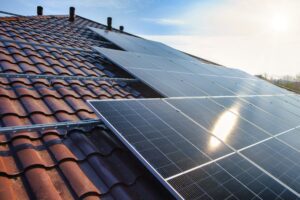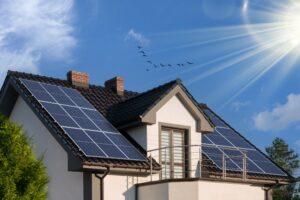Solar panels are becoming an increasingly popular way of generating free, green electricity for both households and businesses. They help save money on energy bills and reduce carbon footprints, as well as reducing dependence on the national grid. However, the solar panel array isn’t the sole piece of solar technology required to produce usable electricity — a solar inverter is needed as part of the solar system to produce the right type of electricity (converting it from DC to AC output).
Solar inverters are usually included as part of a new solar panel system installation. However, they don’t have as long a lifespan as solar panels, so at some point you’ll likely need to replace your inverter, sometime more than once.
Inverters are the heart of a solar PV system and come in a range of sizes (capacities). But how do you know your inverter is correctly sized for optimal performance and matched to your solar panel capacity.
Find out how to identify the right size solar inverter and learn everything else you need to know about solar inverters and their key role in converting electric current.
Alternating Current Vs Direct Current
Electric current is the flow of charged particles such as electrons through a circuit. It’s measured in amps (A). The higher the amperage, the more electricity that’s flowing.
There are two main types of electric current: alternating current and direct current.
In an alternating current (AC), the electrons keep switching directions. This is the most commonly used kind of electric power. It’s produced by power stations for distribution to our homes to provide lighting and heating and run appliances.
In a direct current (DC), electrons flow steadily in one direction. DC is used to power low-voltage electronic devices. It’s also the type of current produced by solar cells – until it is converted by the solar inverter.
How Does a Solar Inverter Work?
A solar inverter has an essential role in how solar photovoltaic (PV) panels generate renewable energy from the sun. It’s what makes solar power usable in our homes.
- When exposed to sunlight, solar panels release electrons that create direct current electricity.
- The photovoltaic inverter converts the direct current into alternating current so it’s compatible with domestic electrical circuits and appliances.
- PV inverters are designed to optimise the amount of energy generated by a solar panel system and reduce losses during DC-AC conversion.
- They control flow of electricity with transformers and transistors that rapidly switch direction of the current back and forth.
- Inverters maximise power output and help ensure the solar technology works safely, with precision monitoring and fault detection features.
Importance of the Solar Inverter
Direct current electricity is used to charge battery-powered devices such as mobile phones and laptops, but common household appliances run on AC electricity. This is because DC electricity loses more energy in the form of heat, which makes it difficult and expensive to distribute. Direct current electricity also poses more of an electrical fire risk.
A solar inverter is vital to produce an alternating current to run household lighting and heating and appliances and devices such as:
- Washing machines and dishwashers.
- Fridges and freezers.
- Electric cookers.
- Microwaves.
- Air fryers.
- Blenders and other kitchen gadgets.
- TVs.
- Desktop computers.
- Vacuum cleaners.
- Power tools.
Types of Solar Inverters
There are several types of solar inverters. The inverter that will work best with your solar panel system depends mainly on how much power your household needs.
String inverters and microinverters are the most widely used solar inverters. Other types include power optimisers and hybrid inverters.
String Inverters
String inverters – the industry standard – have stood the test of time. They’ve been around the longest and are the most commonly used and least expensive.These devices are also known as central inverters because only one inverter is needed for an entire solar panel system.
String inverters are based on proven, affordable technology. They’re connected to a string of multiple solar panels linked end to end.
The inverter is usually installed near the electricity meter or consumer panel, either inside the home or outside on a wall.
Problems with solar arrays are often due to the inverter. When there’s just one, repair is easier, and no one has to climb onto the roof.
If a string inverter breaks down, however, the whole solar panel system will stop working. A string inverter is only as efficient as the lowest-performing module in the solar array.
Microinverters
Unlike string inverters, microinverters are connected directly to individual solar panels. And they work in parallel circuits, with power conversion occurring at the source of energy production.
Microinverters are more efficient than string inverters. They enable each solar panel to function at peak performance independent of other panels. This means output doesn’t depend on the least efficient solar panel in the system. And if one panel breaks down, it won’t greatly affect the entire system.
Microinverters work well with rooftop solar panels that face different directions. You can also monitor each individual panel. This allows you to identify and rectify any problems before they slow down the entire solar energy system.
Microinverters cost significantly more than string inverters but can pay off over time as you get more power from your solar array. Adding more solar panels is easier and less expensive than with a string inverter system.
However, microinverters may not be suitable for simple domestic solar panel systems. And access to the roof is required if a microinverter needs repairing or replacing.
Power Optimisers
Power optimisers sit between string inverters and microinverters in terms of price and functionality. They offer many of the advantages of micro inverters but cost slightly less.
Like microinverters, they’re located on each individual solar panel. But instead of converting DC to AC at roof level, the direct current is directed to a string inverter or hybrid inverter.
Hybrid Inverters
Hybrid solar inverters cost more than string inverters but maximise the solar panel system’s energy use and cost savings.
When the solar panels are producing more electricity than you need, they sell the excess to the national grid or store it in a battery. When the panels don’t produce enough electricity for your home, the inverter draws power from the grid or solar battery.
How Solar Inverters Are Sized
Correct sizing of a solar inverter is crucial. The wrong inverter capacity will weaken the performance of the solar panel system. The inverter has to be able to deal with the amount of energy it’s getting from the panels.
Inverter sizes are measured in watts (W) or kilowatts (kW) – units of a thousand watts – the same as solar panels. Commercial solar systems will require higher capacity inverters.
Inverters work most efficiently at their maximum power and as a general rule should roughly match the solar panel output. For instance, a 3kW solar panel system needs a power inverter of 3kW or thereabouts.
The capacity ratings don’t necessarily have to match exactly. Inverters can be sized lower than the kilowatt peak (kWp) of the solar array. This is because solar panels rarely achieve peak power.
Various other factors also need to be taken into account when deciding on inverter size.
Roof Size
The surface area of your roof is an important consideration when sizing an inverter for your solar panel system. The capacity of the solar array – and therefore size of the inverter required – is determined by how many solar panels can fit on the rooftop.
Location
Geographic location can affect solar panel productivity and the size of inverter required. A solar array that gets more sun (and a higher level of incident solar irradiation) will consistently generate more electricity than an identical system in an area with lower levels of sunlight.
Temperature
Besides the amount of sunlight, temperature also affects solar panel efficiency. If you live in an area with relatively high temperatures, you can probably install a smaller inverter than you would need for the same system in a cooler location.
Other Factors That Influence Solar Inverter Size
Apart from solar panel system size, roof size, location and temperature, other factors that can influence the size of inverter you’ll need include:
- The angle of your solar panels, and their orientation relative to the sun.
- Shade from neighbouring buildings or nearby trees.
- The amount of dust or pollution in the air.
Your installer will take these considerations into account. If they’re negatively affecting your solar panel system productivity, they’ll most likely recommend a smaller-sized inverter.
Calculating Solar Inverter Size
The size of a solar inverter is determined by its maximum output capacity in watts or kilowatts. Within a certain range, the wattage can be higher or lower than that of the solar array without significantly compromising performance.
The inverter wattage you need should be adjusted according to the expected efficiency of your solar panel system, taking into account your specific energy requirements and factors that affect solar panel performance (as detailed above).
Solar Array-to-Inverter Ratio
An important consideration in calculating inverter size is the solar panel system:inverter ratio.
This is the direct current capacity of the solar array divided by the maximum alternating current output of the inverter.
For example, a 3kW solar panel system with a 3kW inverter has an array-to-inverter ratio of 1.0. The same array with a 5kW inverter would have a system:inverter ratio of 1.2.
Most solar installations have a ratio slightly above 1, but usually no more than 1.25. The highest ratio generally recommended is around 1.5.
Undersize or Oversize?
Before deciding to undersize or oversize your solar inverter, you should assess your current and future energy needs. The choice depends on your priorities: immediate optimal efficiency or the potential need for more solar power later.
Undersizing, within limits, can result in more efficient power production during low-light conditions. But there’s a risk of energy clipping.
Solar inverter clipping occurs when the solar panel system produces more power than the inverter can handle. When the inverter’s maximum output rating is exceeded, it will clip (reduce) the amount of electricity available for you to use.
Oversizing an inverter may be a good choice if you’re anticipating adding more solar panels to the system to increase output. You won’t have to upgrade the inverter to a higher wattage when you make the change.
Keep in mind, though, that inverters work at optimal efficiency when operating at or close to their maximum capacity. So installing an inverter considerably larger than your solar panel system will make it less efficient
Solar Inverter Replacement Costs
A solar inverter is usually included in the overall cost of installing solar systems. But when it needs replacing, price can be a big factor in the size of the inverter you’re considering. You’ll find that solar inverter replacement costs vary greatly.
Different types of inverters have different price ranges. For example, a new string inverter for a typical home can cost anywhere from £500 to more than £1,000. Other types of inverters may cost a couple of thousand pounds.
Besides the type of power inverter, costs are also influenced by several other considerations, including potential power output of the inverter and its conversion efficiency.
In general, the higher the cost, the greater the efficiency of the inverter – the percentage of DC input converted to AC output. Top-quality inverters can be significantly more efficient than lower-priced inverters, allowing you to use a slightly smaller inverter.
No inverter is 100% efficient. Some power is lost in the form of heat in the DC-AC power conversion process. That said, PV inverters achieve a high level of energy efficiency. Even lower-cost inverters have an average inverter efficiency conversion rate of around 93%.
Cost of Different Types of Inverters
String inverters, with an average life expectancy of 10 years, typically cost from £500 to £1,500. They usually come with a warranty of five to 10 years.
Microinverters typically range in price from £20 to £100 per solar panel. This can result in a total cost upwards of £2,500 including installation works such as wiring. But microinverters last longer than string inverters – up to 25 years.
Power optimisers typically cost around £40 to £180 for each solar panel. Most come with a 10- to 25-year warranty.
Mid-range hybrid inverters with a lifespan of 10 to 15 years generally cost £1,200 to £1,500.
When Do Solar Inverters Need Replacing?
Solar panels typically last 25 to 30 years. Solar inverters generally have a shorter lifespan because they’re more complex and work harder. You can expect your inverter to last at least 10 years before it needs replacing.
Solar inverters that are monitored and maintained regularly maintain maximum efficiency for longer and last longer in general, especially if they’re located in a cool, shaded spot with good ventilation. The quality of your inverter also influences longevity. Inverters designed to high specifications with quality hardware and more durable materials take longer to lose operational functionality.
Signs of Inverter Problems
There are several indications that a solar inverter isn’t working properly and is affecting efficiency and power output, and therefore may need replacing. These include:
- Significant drop in the solar system energy production.
- Fluctuations in energy production when there’s no change in weather conditions.
- The inverter keeps shutting down unexpectedly.
- Warning lights or error codes are displayed on the inverter display panel.
- Anomalies in monitoring data patterns.
- Physical damage to the inverter, such as corrosion, cracks, or water incursion.
- Clicking or buzzing noises from the inverter.
- The inverter is overheating, which can do permanent damage.
- Frequent tripping of your home’s circuit breaker.
You may be able to rectify some inverter issues yourself by consulting the user manual. In other cases, you may need to call in a professional to repair or replace the inverter.
Your inverter should be monitored particularly closely as it nears the end of its expected lifespan, when it may be more prone to failure.
Benefits of the Right Size Inverter
The right size of inverter is critical to get the full financial and environmental benefit of your solar panel system.
Power inverters play a major part in enabling solar panels to cut annual household electricity bills by almost £1,200 on average, with more savings if you have a solar battery.
Apart from saving money, solar panels provide a clean alternative to carbon fuels such as coal, oil, and natural gas, which drive climate change. Solar power produces no greenhouse gases and leaves a minimal carbon footprint.
And under the Smart Export Guarantee (SEG), you can get paid for excess solar-generated electricity you send back to the grid.
Get Expert Advice on Solar Inverter Sizing
More households and businesses are going solar to meet the growing need to cut energy costs and combat carbon emissions.
Residential and commercial rooftop solar PV panel installations in the UK reached a 12-year-high in 2023. They numbered more than 183,000, a 30% increase on the previous year.
Getting the best performance possible from your solar panel system will maximise your return on the investment. And the solar inverter plays a critical role in this.
If you suspect your solar inverter needs replacing, it’s important to get advice on sizing from an expert.
Effective Home has been installing solar arrays throughout the UK for more than 15 years.
Thousands of householders have cut energy costs by up to 70% with our solar energy installations optimised by carefully selected and correctly sized inverters.
Contact us now to make sure you get the right size inverter for your solar panel system.



